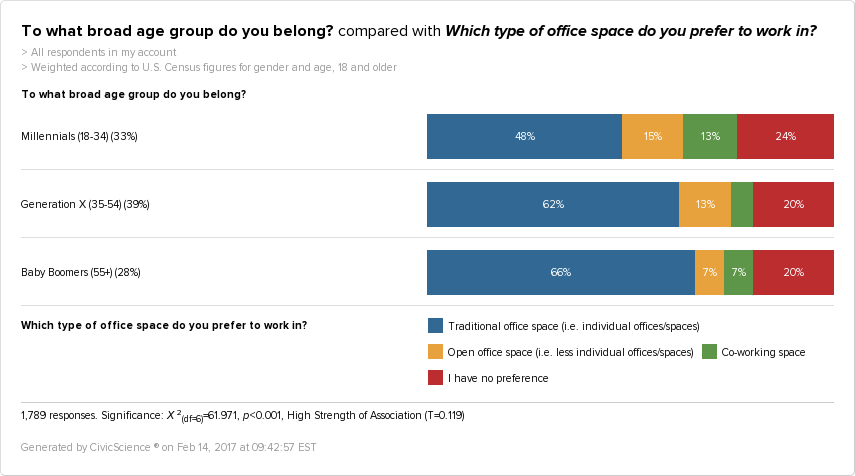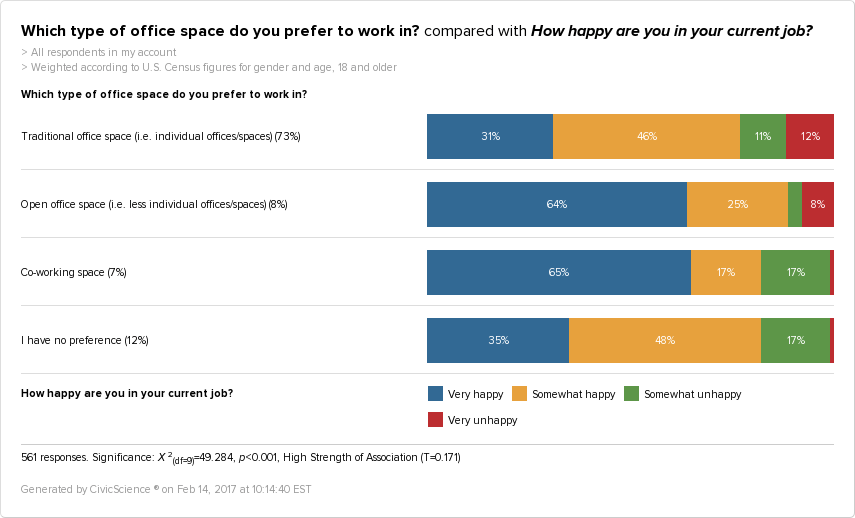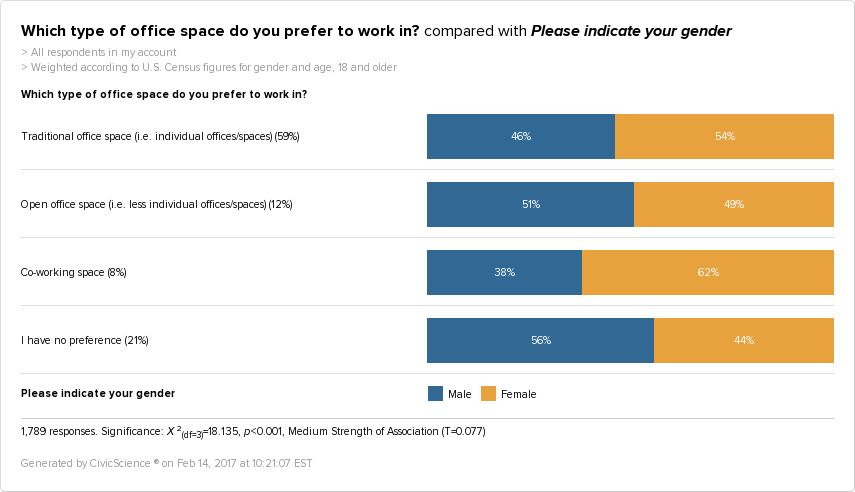As you might already know, co-working spaces are becoming all the rage. Partially, that’s because workspaces can be so expensive that having your own is somewhat of the new American Dream. In other ways, co-working spaces can be a way to fill the void of community that so many people may miss out on otherwise. Sounds good, right?
If not in a co-working space, many offices are turning to open floor plans, which have been thrown into the spotlight by major companies like Google and Amazon. In fact, 70% of U.S. offices now have an open office layout. Why, you ask? These spaces are meant to foster collaboration, creativity, and a transparent work environment. Unfortunately, these spaces might be much less productive than originally thought.
Given the saturation of these new work spaces, imagine our surprise when we ran the following question and came across these results:
Excluding those who answered “Other / Does not apply,” we found that 60% of U.S. adults prefer to work in a traditional office space (for reference, think of a law office). Only 12% of adults prefer to work in an open office space, while only 8% prefer to work in a co-working space.
Even when we consider that co-working spaces and open office spaces are much more geared towards Millennials, it seems that a similar story holds true:
There is a definitive correlation between age and the type of office space a person prefers to work in. Regardless, most Millennials still prefer to work in a traditional office space. Only 15% of Millennials prefer an open office space – which is slightly higher than the general population – and only 13% prefer to work in a co-working space.
Office Space & Job Happiness
Despite this low preference for open and co-working spaces, we did find another interesting correlation – job happiness. As a preface, we did not ask respondents which type of office space they do work in; just which type of office space they prefer to work in. With that in mind, here is what we found:
Adults who prefer to work in a co-working space or an open office space are roughly 2x as likely to say they are “Very happy” in the current in job. Those who prefer to work in a traditional office space are most likely to answer, “Very unhappy.”
Office Preferences by Gender
As you can see, responses are pretty much even between genders, except that those who prefer to work in co-working spaces are much more likely to be women. In addition, those who have no preference for work space are somewhat more likely to be men.
Urban vs. Suburban
This is interesting, though not too surprising. People who prefer to work in co-working spaces are more likely to live in a city. This probably is due to the saturation of fun and innovative co-working spaces that are centered in major cities, and also due to the monumental cost of office space.
Other Fun Facts
These simple demographics weren’t the only interesting tidbits we uncovered.
People who prefer:
- Traditional office spaces are more likely to have graduated from college.
- Traditional office spaces are more likely to earn $100K+ per year.
- Traditional office spaces are more likely to closely monitor their retirement savings.
- Traditional office spaces are more likely to favor restaurants with diverse menu options.
- Open office spaces are more likely to choose TV shows and movies based on social media influence.
- Open office spaces are more likely to follow food and cooking trends.
- Open office spaces are more likely to actively use Instagram.
- Open office spaces are more likely to follow music and technology trends.
- Open office spaces are more likely to tell others about new brands and technology.
- Co-working spaces are more likely to smoke cigarettes.
- Co-working spaces are less likely to earn $100K+ each per year.
Don’t Shoot the Messenger
Companies might want to think twice before jumping on the co-working and open layout bandwagon. Although these spaces provide many benefits, and although they may be fun, it looks like most people are content with traditional office spaces. They might not be as loud, or as collaborative, but the numbers don’t lie.
Interested in other insights? Check out our recent posts on the growing fear of self-driving cars, the potential downfall of the NFL, and perhaps the scariest: Are Millennials Losing the Ability to Empathize?













